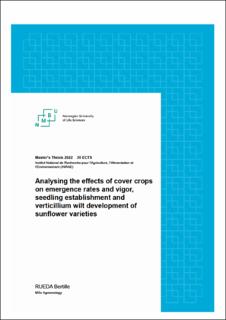| dc.contributor.advisor | Breland, Tor Arvid | |
| dc.contributor.advisor | Duchene, Olivier | |
| dc.contributor.author | Rueda, Bertille Bénédikte Marie | |
| dc.coverage.spatial | France | en_US |
| dc.date.accessioned | 2023-01-03T10:04:50Z | |
| dc.date.available | 2023-01-03T10:04:50Z | |
| dc.date.issued | 2022 | |
| dc.identifier.uri | https://hdl.handle.net/11250/3040549 | |
| dc.description.abstract | Sunflower (Helianthus Annuus) faces major production challenges in southern-western France. It is mostly grown in hilly areas, in short rotations and after a long fallow period during which soils are left bare. Crop establishment issues and fungal attacks are recurrent, causing significant yield losses. The effects of agroecological cover crops (CCs) implementation were assessed on the sunflower emergence rates and vigor, its seedling establishment and on the verticillium wilt development. Four sunflower genotypes were sown in an experimental field, following seven CCs treatments containing diverse mixtures of Fabaceae and Brassicaceae. Ecosystem services provided by these crops families sole or combined were evaluated on the measured variables, in a no-till system and without glyphosate. CCs had a significant impact in this one-year experiment. Weather conditions strongly influenced the decrease in emergence and vigor of sunflower seedlings, as well as the early outbreak of verticillium disease. In general, cover crop residues inhibited seedling emergence by reducing soil-seed contact and depleting the seed reserves. Brassicaceae such as radish and mustard also showed a negative impact on sunflower seedling emergence through allelopathy mechanisms, whereas they reduced verticillium wilt development compared to other treatments. The association with Fabaceae did not allow to conclude on a mutualization of the services provided, except that it possibly diluted the negative effects of Brassicaceae at emergence. A positive correlation between soil mineral nitrogen and verticillium was observed. The hypothesis of an increase in microbial activity weakening the sunflower plants was made. Further studies are needed to understand how Brassicaceae et Fabaceae interact at the different stages of the crop cycle, in order to target and maximize ecosystem services provided by them. | en_US |
| dc.language.iso | eng | en_US |
| dc.publisher | Norwegian University of Life Sciences, Ås | en_US |
| dc.rights | Attribution-NonCommercial-NoDerivatives 4.0 Internasjonal | * |
| dc.rights.uri | http://creativecommons.org/licenses/by-nc-nd/4.0/deed.no | * |
| dc.subject | Helianthus Annuus | en_US |
| dc.subject | Cover crops | en_US |
| dc.subject | Brassicaceae | en_US |
| dc.subject | Fabaceae | en_US |
| dc.subject | Verticillium dahliae | en_US |
| dc.subject | Agroecological protection | en_US |
| dc.title | Analysing the effects of cover crops on emergence rates and vigor, seedling establishment and verticillium wilt development of sunflower varieties | en_US |
| dc.type | Master thesis | en_US |
| dc.subject.nsi | VDP::Agriculture and fishery disciplines: 900 | en_US |
| dc.description.localcode | M-AE | en_US |

